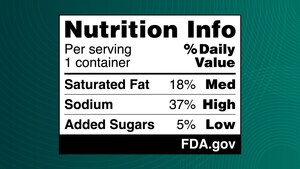SILVER SPRING, Md., June 20, 2023 /PRNewswire/ -- Today, the U.S. Food and Drug Administration approved Jardiance (empagliflozin) and Synjardy (empagliflozin and metformin hydrochloride) as additions to diet and exercise to improve blood sugar control in children 10 years and older with type 2 diabetes. These approvals provide a new class of medicines taken by mouth to treat pediatric type 2 diabetes. Metformin, the only other oral therapy available for the treatment of children with type 2 diabetes, was first approved for pediatric use in 2000.
"Compared to adults, children with type 2 diabetes have limited treatment options, even though the disease and symptom onset generally progress more rapidly in children," said Michelle Carey, M.D., M.P.H., associate director for therapeutic review for the Division of Diabetes, Lipid Disorders, and Obesity in the FDA's Center for Drug Evaluation and Research. "Today's approvals provide much-needed additional treatment options for children with type 2 diabetes."
Type 2 diabetes, the most common form of diabetes, is a chronic and progressive condition in which the body does not make or use insulin normally, leading to high levels of glucose (sugar) in the blood. Based on information from the SEARCH for Diabetes in Youth study, the incidence of type 2 diabetes in children increased by 4.8% per year from 2002 to 2015 and is expected to continue increasing. As of 2017, there were approximately 28,000 cases of type 2 diabetes in children in the U.S. By 2060, if current trends continue, that number is predicted to be approximately 220,000, with the majority of cases occurring in minority racial and ethnic groups such as Non-Hispanic Blacks and Hispanics.
Empagliflozin, the active ingredient in Jardiance and Synjardy, works by increasing the excretion of glucose in the urine. Synjardy also contains metformin.
The safety and efficacy of empagliflozin in children were studied in a double-blind, randomized, placebo-controlled trial in 157 patients aged 10 to 17 years with inadequately controlled type 2 diabetes. Participants were randomly assigned to one of three treatment arms for 26 weeks: empagliflozin, a DPP-4 inhibitor (linagliptin), or placebo. At the beginning of the trial, 51% of patients were taking metformin alone, 40% of patients were taking a combination of metformin and insulin, 3% of patients were taking insulin alone, and 6% of patients were not taking other medicines for diabetes. The trial found that, at week 26, treatment with empagliflozin was superior in reducing hemoglobin A1c, a measure of average blood sugar, compared to placebo. The 52 patients treated with empagliflozin had an average 0.2% decrease in hemoglobin A1c compared with an average 0.7% increase in hemoglobin A1c in the 53 patients taking placebo, representing a 0.8% decrease in hemoglobin A1c with empagliflozin as compared to placebo. Patients treated with empagliflozin also had reductions in fasting plasma glucose, a blood sugar measurement taken after not eating or drinking for at least eight hours, as compared to patients taking placebo.
Common side effects in children treated with empagliflozin were generally similar to those reported in adults, except there was a higher risk of hypoglycemia (low blood sugar) among pediatric patients 10 years and older taking empagliflozin compared to placebo, regardless of whether they were taking other therapies for diabetes.
The most common side effects in adults treated with empagliflozin include urinary tract infections and female fungal infections. The most common side effects in patients treated with metformin include diarrhea, nausea and upset stomach. Jardiance and Synjardy are not recommended in patients with type 1 diabetes because of an increased risk of diabetic ketoacidosis. Jardiance and Synjardy are also not recommended for use to improve blood sugar control in patients with severe kidney problems and should not be used in patients who previously have had a serious allergic reaction to them. Synjardy must not be used in patients with metabolic acidosis or diabetic ketoacidosis (increased ketones in the blood or urine).
For additional information on risks associated with Jardiance and Synjardy, see the prescribing information.
Jardiance was originally approved by the FDA in 2014 as an addition to diet and exercise to improve blood sugar control in adults with type 2 diabetes. Jardiance is also approved to reduce the risk of cardiovascular death in adults with type 2 diabetes and established cardiovascular disease, and to reduce the risk of cardiovascular death and hospitalization for heart failure in adults with heart failure.
Synjardy was originally approved by the FDA in 2015 as an addition to diet and exercise to improve glucose control in adults with type 2 diabetes. Empagliflozin, when used as a component of Synjardy, is approved to reduce the risk of cardiovascular death in adults with type 2 diabetes and established cardiovascular disease and to reduce the risk of cardiovascular death and hospitalization for heart failure in adults with heart failure.
Jardiance and Synjardy received priority review designations for today's approvals. A priority review designation directs overall attention and resources to the evaluation of applications for drugs that, if approved, would be significant improvements in the safety or effectiveness of the treatment, diagnosis or prevention of serious conditions.
The FDA granted today's approvals of Jardiance and Synjardy to Boehringer Ingelheim.
Additional Resources:
Media Contact: Chanapa Tantibanchachai, 202-384-2219
Consumer Inquiries: Email or 888-INFO-FDA (888-463-0332)
The FDA, an agency within the U.S. Department of Health and Human Services, protects the public health by assuring the safety, effectiveness, and security of human and veterinary drugs, vaccines and other biological products for human use, and medical devices. The agency also is responsible for the safety and security of our nation's food supply, cosmetics, dietary supplements, products that give off electronic radiation, and for regulating tobacco products.
SOURCE U.S. Food and Drug Administration

WANT YOUR COMPANY'S NEWS FEATURED ON PRNEWSWIRE.COM?
Newsrooms &
Influencers
Digital Media
Outlets
Journalists
Opted In






Share this article